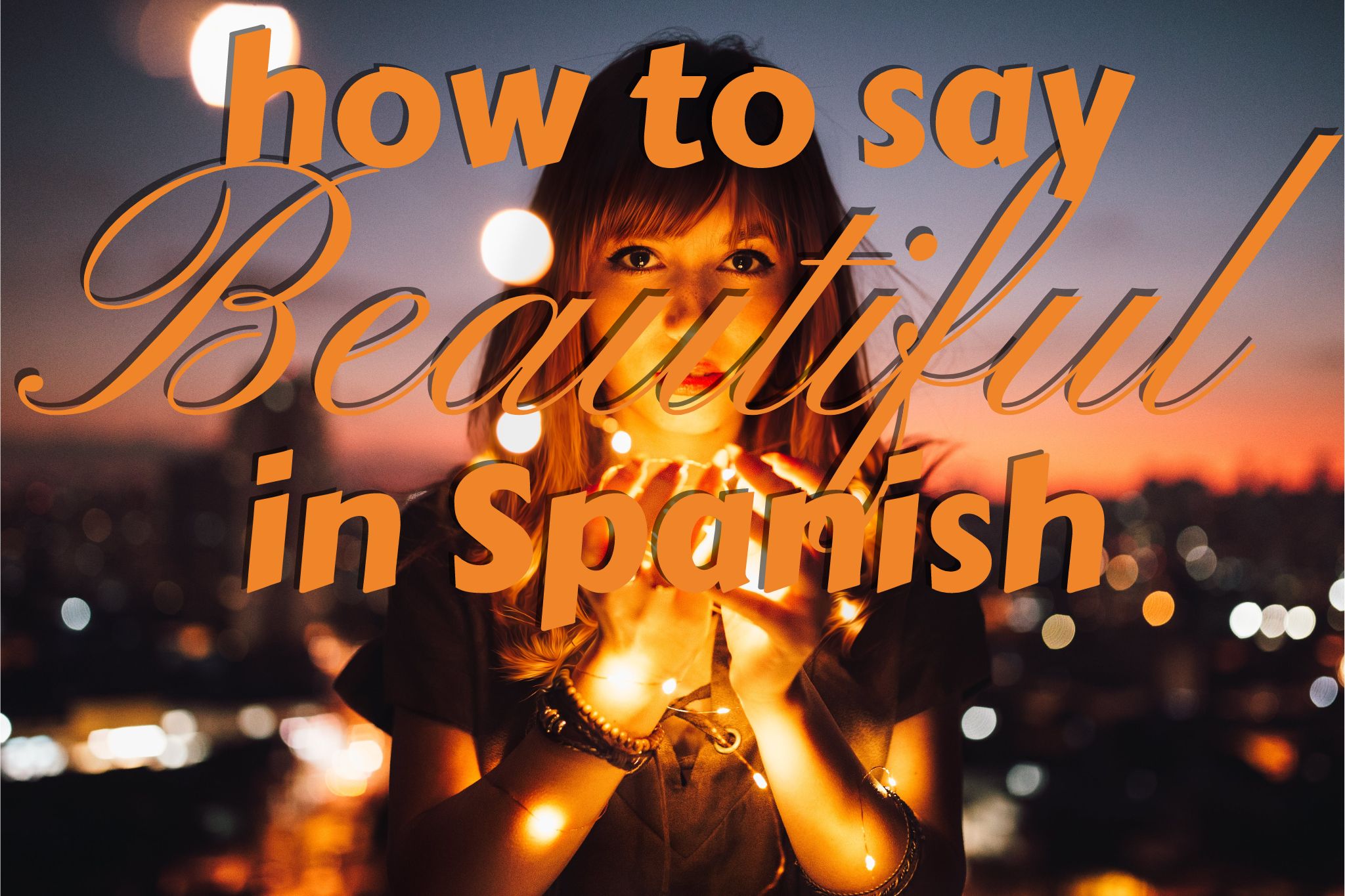How to say Beautiful in Spanish: Let me count the ways!

Get our free email course, Shortcut to Conversational.
Have conversations faster, understand people when they speak fast, and other tested tips to learn faster.
More infoPerhaps it’s a cliché, but it’s definitely true that in Latin cultures we have a wide range of vocabulary to express love, affection, and appreciation for others. Indeed, one of the most outstanding characteristics of our culture has to do with how we normally express and show our feelings!
So whether you’re interested in flirting in Spanish, you want to give compliments in Spanish, or you just want to show some affection to a friend or a family member, you should certainly appreciate knowing how to say beautiful in Spanish in its many forms.
Beautiful in Spanish
Maybe you already know one translation for beautiful in Spanish, which is hermoso or hermosa. Sure, this is the simplest option, but in today’s post we’ll introduce over a dozen other words and phrases to describe a person, an object, or a place as beautiful.
Note that we’re listing the two gender variants for all the Spanish adjectives we provide here, so you have both the masculine and feminine forms for each word. Just remember to add an -s to the end of these when referring to anything in plural. We’ll just mention the base form in our explanations in order to lighten the text, but we’ll be sure to vary the genders in each of our example sentences!
For now, let’s dive into this precioso world of new vocab for beautiful in Spanish!
Hermoso / Hermosa
Hermoso can be translated as beautiful, but it can also mean handsome or gorgeous. We can use hermoso to describe someone’s appearance or personality, and also to describe a beautiful place.
- Emanuel is a handsome man. – Emanuel es un hombre hermoso.
- Patagonia is gorgeous, you have to visit it. – La Patagonia es hermosa, tienes que visitarla.
Precioso / Preciosa
While precioso may be another way of saying beautiful in Spanish, it can also be translated as gorgeous or lovely when talking about people, places, or things.
Precioso can also be used to describe something that’s considered valuable or precious. In this sense, precious has the same double meaning as in English, where you also sometimes use it to describe adorable things like a cute baby or puppy.
- The trekking on that mountain is gorgeous, don’t miss it. – La caminata por la montaña es preciosa, no te la pierdas.
- The cutlery is made of precious metal. – Los cubiertos están hechos de metal precioso.
Bello / Bella
This is another Spanish word for beautiful, but it can also be translated as lovely. We can definitely use bello to describe people, places, or things. So, whenever you come across something or someone beautiful, just say it!
- Melisa is the most beautiful girlfriend I’ve ever had. – Melisa es la novia más bella que he tenido.
- Your kids are lovely! – ¡Qué bellos son tus hijos!
Bonito / Bonita
Bonito is another word meaning beautiful in Spanish, but it isn’t as strong as bello. In most contexts, bonito in Spanish is better translated as pretty or nice when describing people, places, and things.
- His new pet is so pretty. – Su nueva mascota es muy bonita.
- The landscape there is nice. – El paisaje allí es bonito.
Lindo / Linda
Lindo is another of the many options for saying beautiful in Spanish. Other suitable translations for lindo and linda include pretty, nice, lovely, cute, or first-rate.
Lindo is also sometimes used as an adverb, meaning nicely or well. Keep in mind that, if used as an adverb, lindo doesn’t change form to linda. We show this use in our last example here where lindo is used to describe how Zoe sings.
- Finally, we bought a nice house. – Finalmente, compramos una linda casa.
- Teresa’s birthday party was lovely. – La fiesta de cumpleaños de Teresa estuvo muy linda.
- Listen to Zoe’s song, she sings very well. – Escuchá esta canción de Zoe, canta muy lindo.
Guapo / Guapa
This adjective is used to describe an attractive person, so guapo can be translated as handsome and guapa as pretty. We don’t say guapo to describe objects or places.
In some parts of Latin America, guapo is also used to describe a brave person.
- Your boyfriend’s friends are very handsome. – Los amigos de tu novio son muy guapos.
- All I want is beautiful girls. – Yo solo quiero chicas guapas.
Atractivo / Atractiva
Another of the ways to say beautiful in Spanish is atractivo, which translates literally as attractive in English. Atractivo is used to describe people, places, or things that are considered good-looking or appealing.
- Joaquín is as attractive as he is intelligent. – Joaquín es tan atractivo como inteligente.
- All the finalists of the beauty contest are very attractive. – Todas las finalistas del concurso de belleza son muy atractivas.
Divino / Divina
We can use divino to refer to people, places, and things. In general, we can say that someone is divino whether they’re physically beautiful, or if they’re simply a friendly person.
- My new classmates are friendly. – Mis nuevos compañeros de clase son divinos.
- Sofía Vergara looks beautiful in that movie. – Sofía Vergara está divina en esa película.
Mono / Mona
You may recognize the Spanish word mono, which as a noun literally means monkey in Spanish. Used as an adjective, however, mono is employed in many regions to describe someone as beautiful or elegant.
- All the models in that fashion show were beautiful. – Todas las modelos eran muy monas en ese desfile.
- The most important thing is not just to be beautiful, but to be intelligent. – Lo importante no es solo ser mona, sino inteligente.
Chulo / Chula
Chulo is another adjective for beautiful in Spanish. It can also be translated as pretty or nice. It’s used in informal contexts to refer to people, places, and things.
We touch on a bunch of additional angles of this slang term in our related post on qué chulo and qué chula in Spanish.
- After the makeover, the living room was so pretty. – Luego de la reforma, el salón ha quedado muy chulo.
- The dresses in that store are always very beautiful. – Los vestidos de esa tienda siempre son muy chulos.
Rico / Rica
Rico has several meanings in Spanish. In the context of this post on ways to say beautiful in Spanish, we use rico to describe people as cute or even sexy.
Other important translations of rico include tasty and rich, but for now let’s just see some examples with rico meaning cute or sexy!
- Messi’s wife is very sexy. – La esposa de Messi está muy rica.
- My friend told me that all the Broadway dancers are cute. – Mi amiga me dijo que todos los bailarines de Broadway están ricos.
Sexy, Sexi
This term needs no further explanation: sexy is a Spanish word that’s been borrowed from English. We can spell it either way, as either sexi or sexy in Spanish. It’s an invariable adjective, meaning that it doesn’t need to change form depending on whether it describes a man or a woman.
- How sexy you are tonight! – ¡Qué sexi estás esta noche!
- My boyfriend looks very sexy when he dances tango. – Mi novio se ve muy sexy cuando baila tango.
Un bombón
Literally, un bombón is a small chocolate treat that often has a hidden filling inside. As a slang term, un bombón can be used to describe a beautiful person, particularly a woman. Referring to someone as un bombón is an informal way of saying someone is a hottie or a stunner.
Note that unlike the other words for beautiful in Spanish that we’ve seen throughout this post, un bombón is not an adjective. It never changes form as a masculine noun, even though it’s normally used to flatter women.
- I can’t stop looking at you, you’re a beauty. – Eres un bombón, no puedo dejar de mirarte.
- Gastón is a lucky guy, his wife is a beauty. – Gastón es muy afortunado, su esposa es un bombón.
Estar bueno / Estar buena
Among the different ways to describe someone as beautiful in Spanish, we have estar bueno. This phrase uses the verb estar, meaning to be, along with the adverb bueno, meaning fine.
Estar bueno is generally used in informal contexts to describe someone’s physical attractiveness. It can be translated into English with phrases such as to be hot or to be attractive.
- My next-door neighbor is hot, I’ll invite her out. – Mi vecina de al lado esta buena, la voy a invitar a salir.
- Tomi is hot in that suit. – Con ese traje Tomi está bueno.
Adding emphasis or intensifying descriptions
So far we’ve seen a wide selection of adjectives that we can choose between to describe something or someone as beautiful in Spanish. But what if we want to add even more emphasis to our descriptions?
Let’s see the two easiest ways to intensify our descriptions here, whether by simply adding the adverb muy or by using the superlative suffixes -ísimo or -ísima.
Muy
Muy is the most common Spanish adverb we use to intensify the meaning of an adjective or adverb, best translated into English as very. We go into much greater detail on this word in our post on muy vs mucho.
In cases where we want to say that someone or something is very beautiful, we can intensify the words we saw above by adding muy.
- Our trip to Peru was very beautiful. I will never forget it. – Nuestro viaje a Perú fue muy hermoso. Nunca lo olvidaré.
- The comments I received were very nice. – Los comentarios que recibí fueron muy lindos.
Adding -ísimo / -ísima
When the words we’ve just learned are not enough to describe the beauty of someone or something to its highest degree, we can turn them into superlatives by adding the suffixes -ísimo or -ísima.
Keep in mind that not all adjectives can be converted into superlatives. Of the ones we introduced above, sexy, divino, and bonito can’t be transformed this way. Check out our post on superlatives in Spanish for a full lesson.
- The latest novel by Mariana Enriquez is so lovely. – La última novela de Mariana Enríquez es bellísima.
- All the girls at that party were so beautiful. – Todas las chicas eran monísimas en esa fiesta.
Conclusion: Beautiful in Spanish
¡Qué bonito este posteo! – How beautiful this post is!
Now, armed with this varied range of Spanish words for beautiful, you have the tools to praise a friend, flirt with someone, or simply say something nice to someone. Whether you want to use terms like hermoso, precioso, bonito, or guapo, you now have a variety of options to convey your admiration!



